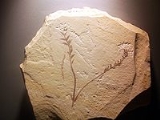
Archaefructus
Encyclopedia
Archaefructus is an extinct
genus of herbaceous
aquatic seed plants with 3 known species. Fossil
material assigned to this genus originates from the Yixian Formation
in northeastern China
, originally dated as late Jurassic
but now thought to be approximately 125 million years old, or early Cretaceous
in age. Even with its revised age, Archaefructus has been proposed to be one of the earliest known genera
of flowering plant
s.
Because of its age, and because it lacks sepal
s and petal
s and its reproductive organs, interpreted as carpels and stamen
s, are produced on an elongate stem rather than condensed into a flower as in modern angiosperms, Archaefructaceae has been proposed as a new basal angiosperm
family. An alternate interpretation of the same fossil, however, interprets the elongate stem as an inflorescence rather than a flower, with staminate (male) flowers below and pistillate (female) flower above. The discovery of Archaefructus eoflora supports this interpretation, because a bisexual flower is present in the region between staminate and pistillate organs. If this interpretation is correct, Archaefructus may not be basal within angiosperms, rather it may be close to the Nymphaeales
or the basal eudicots
.
Extinction
In biology and ecology, extinction is the end of an organism or of a group of organisms , normally a species. The moment of extinction is generally considered to be the death of the last individual of the species, although the capacity to breed and recover may have been lost before this point...
genus of herbaceous
Herbaceous
A herbaceous plant is a plant that has leaves and stems that die down at the end of the growing season to the soil level. They have no persistent woody stem above ground...
aquatic seed plants with 3 known species. Fossil
Fossil
Fossils are the preserved remains or traces of animals , plants, and other organisms from the remote past...
material assigned to this genus originates from the Yixian Formation
Yixian Formation
The Yixian Formation is a geological formation in Jinzhou, Liaoning, People's Republic of China, that spans 11 million years during the early Cretaceous period...
in northeastern China
China
Chinese civilization may refer to:* China for more general discussion of the country.* Chinese culture* Greater China, the transnational community of ethnic Chinese.* History of China* Sinosphere, the area historically affected by Chinese culture...
, originally dated as late Jurassic
Jurassic
The Jurassic is a geologic period and system that extends from about Mya to Mya, that is, from the end of the Triassic to the beginning of the Cretaceous. The Jurassic constitutes the middle period of the Mesozoic era, also known as the age of reptiles. The start of the period is marked by...
but now thought to be approximately 125 million years old, or early Cretaceous
Cretaceous
The Cretaceous , derived from the Latin "creta" , usually abbreviated K for its German translation Kreide , is a geologic period and system from circa to million years ago. In the geologic timescale, the Cretaceous follows the Jurassic period and is followed by the Paleogene period of the...
in age. Even with its revised age, Archaefructus has been proposed to be one of the earliest known genera
Genus
In biology, a genus is a low-level taxonomic rank used in the biological classification of living and fossil organisms, which is an example of definition by genus and differentia...
of flowering plant
Flowering plant
The flowering plants , also known as Angiospermae or Magnoliophyta, are the most diverse group of land plants. Angiosperms are seed-producing plants like the gymnosperms and can be distinguished from the gymnosperms by a series of synapomorphies...
s.
Because of its age, and because it lacks sepal
Sepal
A sepal is a part of the flower of angiosperms . Collectively the sepals form the calyx, which is the outermost whorl of parts that form a flower. Usually green, sepals have the typical function of protecting the petals when the flower is in bud...
s and petal
Petal
Petals are modified leaves that surround the reproductive parts of flowers. They often are brightly colored or unusually shaped to attract pollinators. Together, all of the petals of a flower are called a corolla. Petals are usually accompanied by another set of special leaves called sepals lying...
s and its reproductive organs, interpreted as carpels and stamen
Stamen
The stamen is the pollen producing reproductive organ of a flower...
s, are produced on an elongate stem rather than condensed into a flower as in modern angiosperms, Archaefructaceae has been proposed as a new basal angiosperm
Flowering plant
The flowering plants , also known as Angiospermae or Magnoliophyta, are the most diverse group of land plants. Angiosperms are seed-producing plants like the gymnosperms and can be distinguished from the gymnosperms by a series of synapomorphies...
family. An alternate interpretation of the same fossil, however, interprets the elongate stem as an inflorescence rather than a flower, with staminate (male) flowers below and pistillate (female) flower above. The discovery of Archaefructus eoflora supports this interpretation, because a bisexual flower is present in the region between staminate and pistillate organs. If this interpretation is correct, Archaefructus may not be basal within angiosperms, rather it may be close to the Nymphaeales
Nymphaeales
Nymphaeales is an order of plants, which consists of water lilies and other aquatic plants.This order is considered to be a basal, or early diverging, group of angiosperms...
or the basal eudicots
Eudicots
Eudicots and Eudicotyledons are botanical terms introduced by Doyle & Hotton to refer to a monophyletic group of flowering plants that had been called tricolpates or non-Magnoliid dicots by previous authors...
.

